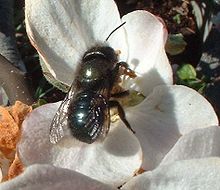
Stayin' Alive
Although most apple trees today are grown in controlled
orchards by humans. Malus domestica has made many
adaptations to better survive in its environment.
One adaption that the apple
tree has made is the apple itself.
The fruit. A fruit is the mature ovary of a flower and surrounds
the seeds to protect it. Fruits also help with the dispersal
of the seed within it. The center of the fruit is arranged into
a five-point star. Each point (carpel) contains one to
three seeds. The sweetness and nutrition of this fruit
attracts other organisms to eat it and since the seeds are
indigestible, they are then later defecated and distributed.
Other examples of plants that utilize fruit include
kiwi,
pomegranate, and
orange trees.
Malus domestica also developed flowers. Flowers are a very
important adaption in the life cycle and survival of the plant.
Malus domestica flowers produce a sweet tasting nectar that
attracts different organisms such as birds or bees that are
looking for nutrition. The organisms, like birds and bees,
that help carry out the process of pollination are called
pollinators. When these organisms come to collect their meal of
nectar, they also collect the pollen grains on them from the
anthers of the flower. Then when the organism goes to
another tree for seconds, it transfers the pollen grain to the
stigma of the flower.
help carry out the process of pollination are called
pollinators. When these organisms come to collect their meal of
nectar, they also collect the pollen grains on them from the
anthers of the flower. Then when the organism goes to
another tree for seconds, it transfers the pollen grain to the
stigma of the flower.
One more important adaptation to Malus domestica is the vascular
cambium. The vascular cambium is the tissue in woody plants
that always it to have secondary growth, which is the growth on
the x-axis, or width. The vascular cambium forms secondary xylem
to the inside and secondary phloem to the outside and is important for strong support of the tree.
The phloem and xylem that the vascular cambium produces are also
important for transforming food and water through out the tree.
